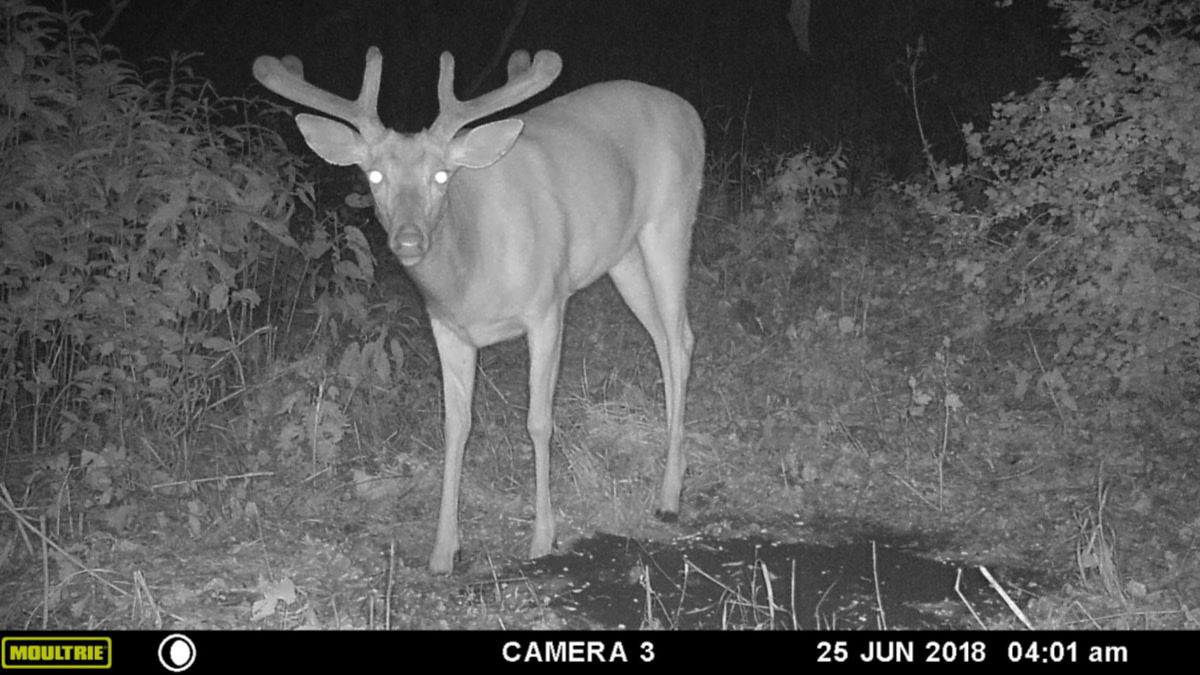
Most hunters who pour bait for deer or bears don’t intend harm, assuming it’s legal. They just want to boost their odds of seeing game, and perhaps better assess an animal’s sex or size before shooting.
Baiters certainly aren’t hauling and dumping food to intentionally spread disease, spark spats with neighbors, boost their prey’s fertility rates, reduce their quarry’s daylight feeding forays, increase predation on fawns and ground-nesters, or poison turkeys and other birds with toxic grain molds.
Intentional or not, those consequences can occur when baiting evolves into long-term, landscape-wide feeding operations, according to wildlife researchers at universities and wildlife agencies. Recent studies also document bait increasing competition between dominant and subordinate deer, sparking conflicts between wildlife and humans, and sowing potential for even more conflicts when bait spigots get capped.
Not all baits, bait piles and baiting regulations are created equal, of course, and some states simply won’t allow it. A 2017 study led by Rebecca Kirby at the University of Wisconsin-Madison notes that of 30 states with a black-bear hunting season, 12 of them allow baiting.
Deer baiting, however, is legal in about 57 percent of Canada and the United States. When the Quality Deer Management Association polled wildlife agencies in Canada and the Lower 48 in 2017, it found six of eight provinces and 26 of 48 states let hunters bait deer. The QDMA’s report noted that deer-baiting regulations vary not only by state, but also within states based on urban hunting, handicapped hunters, private and public lands, or risks from tuberculosis and chronic wasting disease.
New Day, Similar Woes
Complications caused by baiting and feeding wildlife aren’t new, of course. Aldo Leopold, the father of modern wildlife management, often warned that artificial food sources can harm wildlife. In a book of his essays, For the Health of the Land, Leopold wrote that feeding should “not become too easy for the good of the fed.”
Leopold also opposed feeding northern Wisconsin’s deer in winter yards during the 1930s and ’40s. He insisted on antlerless-only hunts to keep deer herds in check with forest habitats.
Leopold’s disdain for artificial feeding was science-based. His writings and speeches on preventing “deer irruptions” mentioned neither ethics nor fair chase. Theodore Roosevelt, however, didn’t shy from such opinions. For instance, he considered it evil to hunt mineral licks.
“Lying in wait at a lick can only be justified on the plea of hunger,” Roosevelt wrote.
In his book The Wilderness Hunter, Roosevelt likened that tactic to shooting deer struggling in water or deep snowdrifts.
“Whoever indulges in any of these methods save from necessity, is a butcher, pure and simple, and has no business in the company of true sportsmen.”
Most baiting/feeding opponents today aren’t so harsh, perhaps because many whitetail hunters have at least one bait bucket in their past and see nuances in baiting. For instance, bait can help position deer or bears for short-range shots. It can also help hunters assess a bear’s size and sex.
Researcher Marci Johnson at the University of Wisconsin-Green Bay, for example, monitored 190 bear-bait sites in two parcels of public forests in northeastern Wisconsin. Johnson notes in her 2007 thesis that male bears made up 54.2 percent of the harvest during the 2003 and 2004 hunting seasons, even though female bears accounted for 87.2 percent of bait visits documented by her trail cameras.
“This difference supports the idea that hunters are able to successfully select for males … by the use of bait sites,” Johnson wrote.
Beyond Moderation?
Johnson and Kirby, however, called on hunters and Wisconsin’s Department of Natural Resources to consider curtailing bait quantities and the state’s bear-baiting period, which lasts from mid-April through early October.
Kirby and her colleagues noted that in the other 11 bear-baiting states, the average start for placing bait is 23 days before the season. Wisconsin, however, opens baiting 145 days before the season and continues it throughout the 35-day hunt. In effect, the researchers noted, many northern Wisconsin bears have access to artificial food at bait sites for all but one week of the time they’re not hibernating.
Kirby documented over one bear-bait station every 1.6 square miles on public forests in her north-central Wisconsin study area, and estimated bait made up over 40 percent of the bears’ diet. That’s a higher percentage of artificial foods than at Yosemite National Park, where human-supplied foods made up 35 percent of bears’ diet in a 1975-1985 study.
Further, a Wisconsin DNR study in 2014 estimated hunters placed 3.9 million gallons of bear bait annually, which includes corn, bread, donuts, pastries, cookies, pudding, frosting, oatmeal, hard candy, gummy bears, dog food and other non-meat products.
That long-lasting, high-sugar diet ensures northern Wisconsin bears enter hibernation fat and fertile, which might explain why the region’s bear population is double the number in neighboring Michigan and Minnesota, where baiting is more restricted. Wisconsin’s black bears historically averaged 2.5 to three cubs per litter, but litters of four to five cubs have become more common the past 20 years as bear baiting boomed.
Applicants for Wisconsin’s bear tags nearly tripled from 44,928 in 1998 to 124,053 in 2018. After documenting the larger bear population a decade ago, the Wisconsin DNR increased its hunting quota. Wisconsin has led the nation in bear hunting the past 10 years, with an average harvest of 4,325 bears annually since 2009, or 50 percent higher than the previous 10-year (1999-2008) average of 2,885.
Ripple Effects
Higher bear numbers can also increase predation on newborn whitetail fawns in spring. A Wisconsin DNR study in 2011 found black bears were the chief predator of fawns in its northwestern study area. Research elsewhere likewise suggests heavily baited areas boost raccoon and feral-hog numbers, which increases turkey-nest predation in spring and habitat destruction year-round.
Despite researchers’ concerns that artificial foods harm the bears’ nutrition, shorten denning periods, make them dependent on humans, boost their numbers above habitat capacities and increase conflicts with people, no serious proposals to restrict bear baiting emerged in Wisconsin.
That doesn’t surprise biologists like Jonathan Gassett, the Wildlife Management Institute’s Southeastern field representative. Gassett served as commissioner of Kentucky’s Department of Fish and Wildlife Resources from 2006 through 2013, and recalls many bait-related battles.
“Baiting deer was legal year-round when I started working to ban it,” Gassett said. “That wasn’t a pleasant experience, politically or otherwise, but we stopped baiting pretty much for everything except deer. Kentucky doesn’t allow baiting on public lands, either. It causes too many problems.”
Gassett cites turf wars between hunters, reduced daylight deer movements, increased competition between deer at bait sites and the likelihood of spreading diseases to deer and other wildlife. He also implicated mold toxins in corn and grains for wildlife health problems.
“The stuff sold as ‘deer corn’ is often condemned agricultural feed that can’t be fed to humans or livestock,” Gassett said. “Mycotoxins in moldy corn usually don’t hurt deer, because they can digest just about anything. But it can kill turkeys and songbirds. Bottom line: We shouldn’t be feeding wildlife. We’ve known that for 100 years. I’m all for managing woodlots, native vegetation, native terrains and food plots.”
Gassett said research on food plots documents benefits beyond deer, including birds, mice, rabbits, insects and pollinators. For instance, a 2016 University of Georgia study led by Wilson E. Ricks found songbird species were “rich” in number and variety along food-plot edges in southern Appalachian hardwood forests, including several species classified as “declining.”
Gassett and most biologists also worry that bait sites could help spread CWD. A 2018 University of Wisconsin-Madison study found detectable levels of CWD-causing prions in soil and water at nine of 11 mineral licks researchers monitored in the state’s endemic area, as well as in feces at one of the more infected sites. The concentrated nature of licks and bait sites makes it likely that deer share food particles, and shed high levels of prions when urinating, defecating and salivating. Saliva likely has the highest potential to transmit CWD. The study notes saliva from infected whitetails contains one to five infectious doses of prions.
Regulating Ethics?
Attempts to regulate or outlaw baiting, however, don’t necessarily end the practice or its challenges. Wisconsin, for example, has steadily expanded its bait ban as CWD spread into new areas. Even so, baiting has been deer hunting’s top violation since the Wisconsin’s Legislature overruled the DNR’s bait ban in 2003, and let hunters in non-CWD areas use up to 2 gallons of bait per 40-acre parcel.
Three years later, Wisconsin’s chief warden, Randy Stark, expressed frustration after wardens wrote a then-record 299 baiting citations during the 2006 gun-deer season.
“No single issue in my 23 years as a conservation warden has consumed as many pages of warden (reports) like baiting and feeding issues have this year,” Stark said.
In the 12 deer seasons since, Wisconsin’s deer baiting/feeding violations have worsened, totaling 6,003 unofficially. That’s an annual average of 501, including a high of 692 in 2009 and a low of 403 in 2018. At roughly $523 per citation, that’s $3.14 million in deer-baiting fines.
Bait-hunters might not intend harm, but those numbers suggest stubborn indifference to baiting’s consequences, financial and otherwise, in regions where baiting is popular.






Conversation